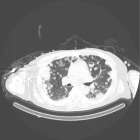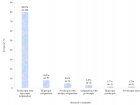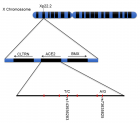Abstract
Research Article
SARS-CoV-2 infection and phylogenetic analysis with the risk factors in human body alongside the pulmonary effects and medication
Mauro Luisetto*, Ahmed Yesvi Rafa, Naeem Musa, Md. Abu Syed, Sabit Ibtisam Anan and Tazwan Haque
Published: 06 November, 2020 | Volume 4 - Issue 1 | Pages: 023-029
Related the extremely transmittable abilities of SARS-CoV-2,a harmonious virus to the bat CoV, gets transmitted by three principal processes-- the inhalation of droplets from the SARS-CoV-2 infected person, contacting to the person, and by the surfaces and materials defiled with the virus. Whereupon bat Coronavirus is mostly like the pandemic causing virus SARS-CoV-2, bats are often deliberated and figured out as a possible primary host although no intermediate has not been defined yet in the wherewithal of transmission. The Spike Glycoprotein plays an important role in the case of penetration with the assistance of the ACE2 receptor and the Receptor Binding Domain. In the human body, infiltrating the nucleic acid into host cells, SARS-CoV-2 attacks one cell and one by one into the whole human body; therefore, infected cases are found symptomatic and asymptomatic considering the immune power. Patients with cardiovascular disease or diabetes proceed with their treatment with ACE2 often; therefore, there might be a high chance of getting infected. Whereas the SARS-CoV-2 infects the blood and then lungs, Antigens improvement can be better in order to avoid high-complicated effects. Currently, no vaccination or no accurate cure and treatment has not been defined. An explanation with analysis on SARS-CoV-2 has been performed from the aspect of virology, immunology and molecular biology. Several relevant figures have been included hereby in order to a better understanding of the very concept.
Read Full Article HTML DOI: 10.29328/journal.ibm.1001018 Cite this Article Read Full Article PDF
Keywords:
SARS-CoV-2; Biological fl uid; Penetration; Pulmonary; Zoonotic
References
- Rafa AY, Luisetto M, Musa N, Arif OB, Ilman A, et al. “A Study on SARS-CoV-2 Penetration Process and Pathogenesis Analysis based on the Biological Mechanism as well as Medication to Alleviate the Impacts on Human Body. Adv Bioengin Biomed Sci Res. 2020; 3: 92-100. https://www.opastonline.com/storage/2020/09/a-study-on-sars-cov-2-penetration-process-and-pat hogenesis-analysis-based-on-the-biological-mechanism-as-well-as-medication-to-alleviate-the-im pacts-on-human-body-abbsr-20.pdf
- Potus F, Mai V, Lebret M, Malenfant S, Breton-Gagnon E, et al. Novel insights on the pulmonary vascular consequences of COVID-19. Am J Physiol Lung Cell Mol Physiol. 2020; 319: L277-L288. PubMed: https://pubmed.ncbi.nlm.nih.gov/32551862/
- McGonagle D, O'Donnell JS, Sharif K, Emery P, Bridgewood C. Immune mechanisms of pulmonary intravascular coagulopathy in COVID-19 pneumonia. The Lancet Rheumatology. 2020; 2: e437-e445. PubMed: https://pubmed.ncbi.nlm.nih.gov/32835247/
- Patanavanich R, Glantz SA. Smoking is associated with COVID-19 progression: A meta-analysis. Nicotine Tob Res.2020; 22: 1653-1656. PubMed: https://pubmed.ncbi.nlm.nih.gov/32399563/
- Liu X, Long C, Xiong Q, Ma J, Chen C, et al. Association of renin-angiotensin-Aldosterone system inhibition with risk of COVID-19, inflammation level severity and death in patients with COVID-19: A rapid systematic review and meta-analysis. 2020.
- Shahreen MA, Khan S, Kazmi A, Bashir N, Siddique R. COVID- 19 infection: Origin, transmission, and characteristic of human coronaviruses. Journal of Advanced Research, Elsevier, Sciencedirect. 2020; 24: 91-98. PubMed: https://www.ncbi.nlm.nih.gov/pmc/articles/PMC7113610/
- Winkler ES, Bailey AL, Kafai NM, et al. SARS-CoV-2 Infection of Human ACE2-transgenic Mice Causes Severe Lung Inflammation and Impaired Function. Nat Immunol.2020; 21: 1327-1335. PubMed: https://pubmed.ncbi.nlm.nih.gov/32839612/
- Rafa AY, Luisetto M, Musa N, Arif OB, Ilman A, et al. A Study on the Biological Mechanism of SARS-CoV-2, its Impacts, and Adversities on the Human Body and Medication to Alleviate its Impacts. Virology & Mycology. 2020; 9: 192 https://www.longdom.org/abstract/a-study-on-the-biological-mechanism-of-sarscov2-its-impactsand-adversities-on-the-human-body-and-medications-to-allevia-57704.html
- Perlman S. Another Decade, Another Coronavirus. NEJM. 2020; 382: 760-762. https://www.nejm.org/doi/full/10.1056/NEJMe2001126
- Jaimes JA, André NM, Chappie JS, Millet JK, Whittaker GR. Phylogenetic Analysis and Structural Modeling of SARS-CoV-2 Spike Protein Reveals an Evolutionary Distinct and Proteolytically Sensitive Activation Loop. J Mol Biol. 2020; 432: 3309-3325 PubMed: https://pubmed.ncbi.nlm.nih.gov/32320687/
- Burke CW. Coronavirus Transmission: Where the Virus Goes in your Body and How it is Spread?” Biospace. 2020. https://www.biospace.com/article/all-the-ways-we-know-that-you-can-get-coronavirus/
- Xiong Y, Liu Y, Cao L, Wang D, Guo M, et al. Transcriptomic characteristics of Bronchoalveolar lavage fluid and peripheral blood mononuclear cells in COVID-19 patients. Emerg Microbes Infect. 2020; 9: 761-770 PubMed: https://pubmed.ncbi.nlm.nih.gov/32228226/
- Seminara G, Carli B, Forni G, Fuzzi S, Mazzino A, et al. Biological fluid dynamics of airborne COVID-19 infection. R endiconti Lincei. Scienze Fisiche e Natural. 2020; 31: 505-537.
- Mohseni AH, Taghinezhad SS, Xu Z, Fu X. Body fluids may contribute to human-to-human transmission of severe acute respiratory syndrome coronavirus 2: Evidence and practical experience. Chin Med. 2020; 15: 58. PubMed: https://pubmed.ncbi.nlm.nih.gov/32514291/
- Ackermann M, Verleden SE, Kuehnel M, Haverich A, Welte T, et al. Pulmonary vascular Endothelialitis, thrombosis, and angiogenesis in COVID-19. New Eng J Med. 2020; 383: 120-128. PubMed: https://pubmed.ncbi.nlm.nih.gov/32437596/
- Di Gennaro F, Pizzol D, Marotta C, Antunes M, Racalbuto V, et al. Coronavirus Diseases (COVID-19) Current Status and Future Perspectives: A Narrative Review. Int J Environ Res Public Health. 2020; 17: 2690; PubMed: https://pubmed.ncbi.nlm.nih.gov/32295188/
- Zhou P, Yang XL, Wang XG, Hu B, Zhang L, et al. A pneumonia outbreak associated with a new coronavirus of probable bat origin. Nature. 2020; 579: 270–273.
- Lam TT, Jia N, Zhang Y. et al. Identifying SARS-CoV-2-related coronaviruses in Malayan pangolins. Nature. 2020; 583; 282–285 PubMed: https://pubmed.ncbi.nlm.nih.gov/32218527/
- dos Santos B, Valença, IN, de Cassia Ruy, P, et al. The novel coronavirus SARS-CoV-2: From a zoonotic infection to coronavirus disease-2019. J Med Virol. 2020; 1– 9.
- Marc L, Swerdlow, David L. and Finelli, Lyn. Defining the Epidemiology of COVID-19 — Studies Needed. New Zealand J Med.2020; 382: 1194-1196. PubMed: https://pubmed.ncbi.nlm.nih.gov/32074416/
- Sajadi MM, Habibzadeh P, Vintzileos A, Shokouhi S, Miralles-Wilhelm F, et al. Temperature and latitude analysis to predict potential spread and seasonality for COVID-19. S SRN Electronic J. 2020.
- Morawska L, Tang JW, Bahnfleth W, Bluyssen PM, Boerstra A, et al. How can airborne transmission of COVID-19 indoors be minimised? Environ Int. 2020; 142: 105832. PubMed: https://www.ncbi.nlm.nih.gov/pmc/articles/PMC7250761/
- Rocklöv J, Sjödin H. High population densities catalyse the spread of COVID-19. J Travel Med. 2020; 27: PubMed: https://pubmed.ncbi.nlm.nih.gov/32227186/
- Tindale L, Coombe M, Stockdale JE, Garlock E, Lau WY, et al. Transmission interval estimates suggest pre-symptomatic spread of COVID-19. 2020.
- Dehning J, Zierenberg J, Spitzner FP, Wibral M, Neto JP, et al. Inferring change points in the spread of COVID-19 reveals the effectiveness of interventions. Science. 2020; 369: eabb9789 PubMed: https://pubmed.ncbi.nlm.nih.gov/32414780/
- Wadman M, Couzin-Frankel J, Kaiser J, Matacic C. How does coronavirus kill? Clinicians trace a ferocious rampage through the body, from brain to toes. Science. 2020. https://www.sciencemag.org/news/2020/04/how-does-coronavirus-kill-clinicians-trace-fe rocious-rampage-through-body-brain-toes
Figures:

Figure 1
Similar Articles
-
SARS-CoV-2 infection and phylogenetic analysis with the risk factors in human body alongside the pulmonary effects and medicationMauro Luisetto*,Ahmed Yesvi Rafa,Naeem Musa,Md. Abu Syed,Sabit Ibtisam Anan,Tazwan Haque. SARS-CoV-2 infection and phylogenetic analysis with the risk factors in human body alongside the pulmonary effects and medication. . 2020 doi: 10.29328/journal.ibm.1001018; 4: 023-029
-
Phytochemicals candidates as promising preventives and/or curatives for COVID-19 Infection: A brief reviewSelma Hamimed*,Nejib Jebli,Rayene Hamimed,Ahmed Landoulsi,Abdelwaheb Chatti. Phytochemicals candidates as promising preventives and/or curatives for COVID-19 Infection: A brief review. . 2021 doi: 10.29328/journal.ibm.1001019; 5: 001-006
Recently Viewed
-
Drinking-water Quality Assessment in Selective Schools from the Mount LebanonWalaa Diab, Mona Farhat, Marwa Rammal, Chaden Moussa Haidar*, Ali Yaacoub, Alaa Hamzeh. Drinking-water Quality Assessment in Selective Schools from the Mount Lebanon. Ann Civil Environ Eng. 2024: doi: 10.29328/journal.acee.1001061; 8: 018-024
-
Rapid Microbial Growth in Reusable Drinking Water BottlesQishan Liu*,Hongjun Liu. Rapid Microbial Growth in Reusable Drinking Water Bottles. Ann Civil Environ Eng. 2017: doi: 10.29328/journal.acee.1001007; 1: 055-062
-
Beneficial effects of a ketogenic diet in a woman with Charcot-Marie-Tooth diseaseElvira Rostanzo,Anna Maria Aloisi*. Beneficial effects of a ketogenic diet in a woman with Charcot-Marie-Tooth disease. Arch Food Nutr Sci. 2022: doi: 10.29328/journal.afns.1001040; 6: 068-072
-
Isolation and Influence of Carbon Source on the Production of Extracellular Polymeric Substance by Bacteria for the Bioremediation of Heavy Metals in Santo Amaro CityLeila Thaise Santana de Oliveira Santos*, Kayque Frota Sampaio, Elisa Esposito, Elinalva Maciel Paulo, Aristóteles Góes-Neto, Amanda da Silva Souza, Taise Bomfim de Jesus. Isolation and Influence of Carbon Source on the Production of Extracellular Polymeric Substance by Bacteria for the Bioremediation of Heavy Metals in Santo Amaro City. Ann Civil Environ Eng. 2024: doi: 10.29328/journal.acee.1001060; 8: 012-017
-
Management and use of Ash in Britain from the Prehistoric to the Present: Some implications for its PreservationJim Pratt*. Management and use of Ash in Britain from the Prehistoric to the Present: Some implications for its Preservation. Ann Civil Environ Eng. 2024: doi: 10.29328/journal.acee.1001059; 8: 001-011
Most Viewed
-
Evaluation of Biostimulants Based on Recovered Protein Hydrolysates from Animal By-products as Plant Growth EnhancersH Pérez-Aguilar*, M Lacruz-Asaro, F Arán-Ais. Evaluation of Biostimulants Based on Recovered Protein Hydrolysates from Animal By-products as Plant Growth Enhancers. J Plant Sci Phytopathol. 2023 doi: 10.29328/journal.jpsp.1001104; 7: 042-047
-
Sinonasal Myxoma Extending into the Orbit in a 4-Year Old: A Case PresentationJulian A Purrinos*, Ramzi Younis. Sinonasal Myxoma Extending into the Orbit in a 4-Year Old: A Case Presentation. Arch Case Rep. 2024 doi: 10.29328/journal.acr.1001099; 8: 075-077
-
Feasibility study of magnetic sensing for detecting single-neuron action potentialsDenis Tonini,Kai Wu,Renata Saha,Jian-Ping Wang*. Feasibility study of magnetic sensing for detecting single-neuron action potentials. Ann Biomed Sci Eng. 2022 doi: 10.29328/journal.abse.1001018; 6: 019-029
-
Pediatric Dysgerminoma: Unveiling a Rare Ovarian TumorFaten Limaiem*, Khalil Saffar, Ahmed Halouani. Pediatric Dysgerminoma: Unveiling a Rare Ovarian Tumor. Arch Case Rep. 2024 doi: 10.29328/journal.acr.1001087; 8: 010-013
-
Physical activity can change the physiological and psychological circumstances during COVID-19 pandemic: A narrative reviewKhashayar Maroufi*. Physical activity can change the physiological and psychological circumstances during COVID-19 pandemic: A narrative review. J Sports Med Ther. 2021 doi: 10.29328/journal.jsmt.1001051; 6: 001-007

HSPI: We're glad you're here. Please click "create a new Query" if you are a new visitor to our website and need further information from us.
If you are already a member of our network and need to keep track of any developments regarding a question you have already submitted, click "take me to my Query."
















































































































































